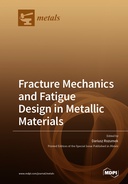Explore

Fracture Mechanics and Fatigue Design in Metallic Materials
0 Ungluers have
Faved this Work
Login to Fave
The accumulation of damage and the development of fatigue cracks under the influence of loads is a common phenomenon that occurs in metals. To slow down crack growth and ensure an adequate level of safety and the optimal durability of structural elements, experimental tests and simulations are required to determine the influence of various factors. Such factors include, among others, the impact of microstructures, voids, notches, the environment, etc. Research carried out in this field and the results obtained are necessary to guide development toward the receipt of new and advanced materials that meet the requirements of the designers. This Special Issue aims to provide the data, models and tools necessary to provide structural integrity and perform lifetime prediction based on the stress (strain) state and, finally, the increase in fatigue cracks in the material.
This book is included in DOAB.
Why read this book? Have your say.
You must be logged in to comment.
Rights Information
Are you the author or publisher of this work? If so, you can claim it as yours by registering as an Unglue.it rights holder.Downloads
This work has been downloaded 114 times via unglue.it ebook links.
- 114 - pdf (CC BY) at Unglue.it.
Keywords
- 2524-T3 aluminum alloy
- alloy 625
- aluminum hand-hole
- artificial neural network
- CFRP patches
- Corrosion
- CP Ti
- crack branching behavior
- crack front shape
- crack growth rate
- crack propagation
- crack propagation path
- crack retardation
- design S-N curve
- environmentally assisted cracking
- failure analysis
- Fatigue
- fatigue crack growth
- fatigue crack propagation
- fatigue test
- fatigue variability
- fish eye
- fractography
- Fracture
- fracture toughness
- galvanic protection
- high cycle fatigue
- high strength steel
- high-entropy alloy
- hydrogen re-embrittlement
- Machine learning
- micromechanical analysis
- Microstructure
- n/a
- nonreinforced hand-hole
- pearlitic steel
- powder metallurgy
- predictor
- roughness-induced crack closure
- small-scale yielding
- specimen size
- steady-state loading conditions
- stress amplitude
- stress concentration
- structural plates
- Technology, engineering, agriculture
- Technology: general issues
- tensile strength
- thin tube
- through-the-thickness crack
- titanium alloy
- ultra-high frequency
- very high cycle fatigue
- very-high cycle
- vibration-based fatigue
- welded joints
- yield stress
Links
DOI: 10.3390/books978-3-0365-2731-4Editions

